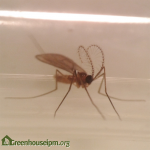Aphidoletes aphidmyza
Description
Aphidoletes aphidimyza is a predatory midge whose larvae are voracious predators of all aphid species, capable of handling heavy pest pressure. The adults have delicate legs and wings, so special care must be taken during release so as not to damage them.
Adult Aphidoletes are small (2-3mm long) flies that resemble mosquitoes, with long, delicate legs and antennae. The larvae are legless, resembling maggots which grow up to 3mm in length, and have a distinctive orange colour.
Biology
Adult female Aphidoletes lay their eggs on aphid-infested leaves. Each female can lay up to 300 eggs in her 1-2 week life span. Eggs hatch after 2-3 days and begin feeding on aphids by injecting the aphids with a toxin that paralyzes them, and sucking out the body fluids, killing the aphid. When aphid densities are high, Aphidoletes larvae will kill more than they need to consume, killing up to 50 aphids per day during their larval stage. Larval development takes approximately 2 weeks, after which they will drop to the soil to pupate. During spring and summer, new adults will emerge in 2-3 weeks.
During the fall and winter months, under low light, and/or short days, they may enter diapause during the pupal stage. This makes it difficult for Aphidoletes populations to establish in the greenhouse during fall and winter, particularly if supplemental lighting is not used. However, this does not affect the number of eggs laid by adult females, or the predatory ability of the first generation of larvae. They are therefore still a useful biocontrol agent in fall and winter months, particularly if there are larger populations of aphids that need to be managed. In a long term crop, any Aphidoletes that entered diapause in the fall and winter may begin to emerge as adults again in the spring.
Recommendations for use
Adult Aphidoletes have a good dispersal ability and are efficient at locating aphid hot spots.
Packaging
- Aphidoletes are shipped as pupae in bottles with vermiculite
- Refer to the Quality Assurance of Biocontrol Products to determine the quality of the Aphelinus at receipt at the greenhouse.
Distribution techniques
- Open bottle and set out in greenhouse for Aphidoletes to emerge on their own
- Do not scatter contents of bottle as this can damage their delicate legs and wings
Introduction rates
- Preventative: not recommended
- Curative: 0.5-1m2
Environmental considerations
- Aphidoletes will enter diapause under low light, and short day lengths and may have difficulty establishing in the fall, and winter. Larvae don’t enter diapause until they reach their pupal stage, making them effective predators during their first generation.
- Using bright, supplemental lighting, and maintaining temperatures above 15°C can help prevent diapause
- Aphidoletes perform best at 20-25°C and high humidity of 70% or higher
Monitoring
- Adults are nocturnal and are not often seen
- Orange larvae may be spotted among aphid colonies
- Desiccated aphid bodies are left behind by larvae after feeding
Factors affecting:
- Please consult the Quick Reference Guide to Registered Pesticides made by OMAFRA for compatibility information of products registered in Canada. Koppert and Biobest also have pesticide compatibility information listed on their websites.


